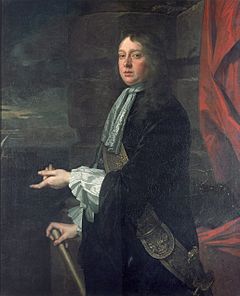Western Design facts for kids
Quick facts for kids Western Design |
|||||||||
|---|---|---|---|---|---|---|---|---|---|
| Part of Anglo-Spanish War (1654–60) | |||||||||
 Oliver Cromwell; the Design was part of an ambitious plan to oust Spain from the Americas |
|||||||||
|
|||||||||
| Belligerents | |||||||||
| Commanders and leaders | |||||||||
|
|||||||||
| Strength | |||||||||
|
|
||||||||
| Casualties and losses | |||||||||
| over 1,000 | |||||||||
The Western Design was a big plan by England to attack Spanish lands in the Caribbean. This happened during the Anglo-Spanish War (1654-1660).
The English leader, Oliver Cromwell, wanted to end Spain's power in the Americas. His plan involved sending many ships and soldiers. However, the troops were not well-trained, and they lacked enough supplies. The two main commanders, Robert Venables (for land) and Admiral William Penn (for sea), did not get along. They did not trust each other.
The English tried to attack Hispaniola (an island now shared by Haiti and the Dominican Republic), but they failed. After that, they captured the island of Jamaica. This island then became an English territory.
Contents
Why the Western Design Happened
The main goal of this expedition was to attack the Spanish West Indies. England wanted to create a lasting military base in the Caribbean. This base would allow English ships to threaten the important trade routes. These routes connected Spanish America with Europe.
The idea for this plan came from the Providence Island Company. This was an English colony started in 1630 near Nicaragua. It was later abandoned in 1641.

The English government first talked about the plan in 1654. It was based on advice from Thomas Gage. He was a former missionary who knew a lot about the region. Gage believed that Spanish colonies like Hispaniola and Cuba were easy to capture. He thought they were not well-defended. However, this advice turned out to be wrong.
Some military leaders, like John Lambert, thought the plan was too expensive. They also felt it would not work. But Oliver Cromwell strongly supported it. He had been involved with the Providence colony before.
Cromwell had just ended a war with the Dutch Republic (1652-1654). He wanted England and the Dutch to join forces. This would combine the two strongest navies in Europe. Together, they could control trade and make demands to Catholic countries like France and Spain. The Western Design was meant to be the first step. It aimed to remove Spain from the Americas. Even though the Dutch said no to joining, Cromwell went ahead with his plan. He believed that God was on his side because of his past victories. This strong belief meant that the failure of the Western Design greatly affected him and many others.
Preparing for the Journey
Cromwell's brother-in-law, General John Disbrowe, helped manage the supplies. The war with the Dutch had ended, so the English army was getting smaller. This expedition was a way to use the extra soldiers.
However, not many soldiers wanted to go to the Caribbean. This area was known for many diseases. Out of 2,500 soldiers who left England, less than half were experienced. The rest were new recruits who had not been trained well.
The land forces were led by Robert Venables. He was a skilled soldier who had fought in Ireland. Cromwell thought highly of him. But Venables complained about the poor condition of his troops, and his concerns were not listened to.
Venables shared command with Admiral William Penn. Penn had a fleet of eighteen warships and twenty transport ships. He was also an experienced and capable officer. But having two commanders led to arguments and bad feelings between them.
They were joined by Daniel Searle, who was the Governor of Barbados. Two civilian leaders also came along: Edward Winslow, a former Governor, and Gregory Butler. Their job was to oversee the settlement of any captured lands.
The Expedition Begins
The English fleet left Portsmouth in England in December 1654. They arrived in Barbados about a month later. In Barbados, they gathered more soldiers. Between three and four thousand new troops joined them. These were volunteers from other English colonies like Barbados, Montserrat, Nevis, and St Kitts. This brought the total number of soldiers to about 6,500.
While the number of troops seemed impressive, they were not well-trained. They also had poor discipline. Supplies were running low, and the two commanders, Penn and Venables, were still arguing. The soldiers' spirits dropped even lower when the civilian leaders told them something important. They were not allowed to steal from the Spanish colonies they were about to attack. Instead, they had to keep everything untouched for future English settlement.
The main target was Hispaniola. The English attacked it in April 1655. But the attack failed, and many English soldiers died from disease. In May, they captured the island of Jamaica, which was not well-defended. However, the expedition did not achieve its main goals.
What Happened Next
Venables and Penn quickly sailed back to England on different ships. Both hoped to blame the other for the failure. They were charged with leaving their posts without permission and were removed from the military. Penn later returned to the navy after 1660, but this ended Venables' military career.
Even though Charles II had promised to return any land taken from Spain, he did not keep this promise after he became king in 1660. Jamaica remained an English possession.
England saw Jamaica as a key point against the Spanish Empire. However, at first, it was not very valuable economically. Spain tried several times to get Jamaica back. But they officially gave up the island in 1670 with the Treaty of Madrid. Jamaica stayed under British control for over 300 years. It finally became an independent country in 1962.
Sources


